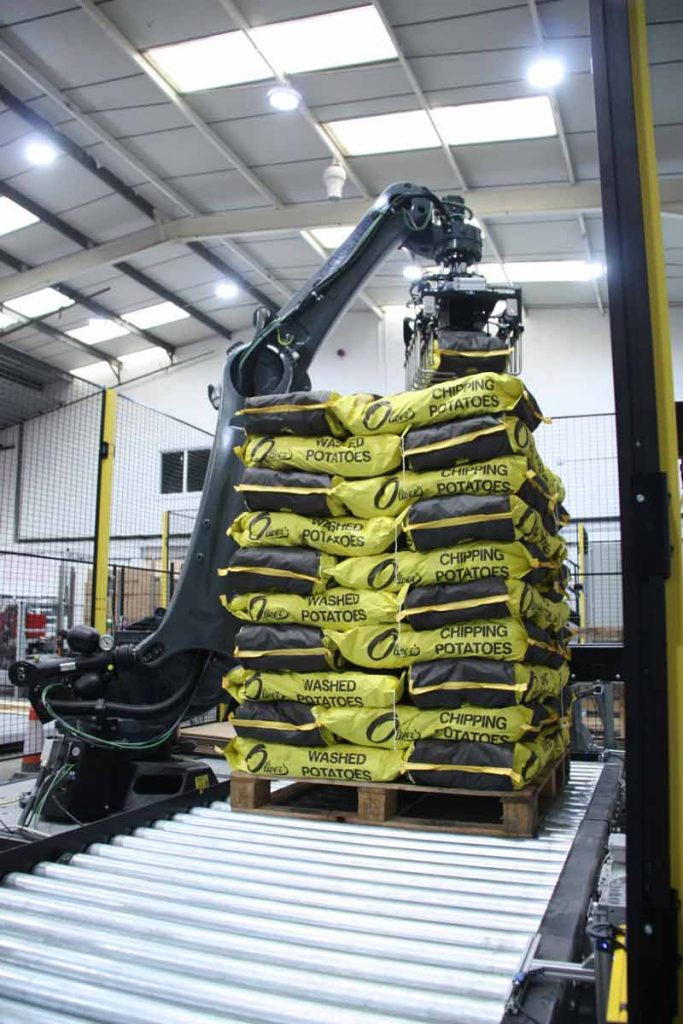Put simply, robotic palletisers pick and place product from your production line onto a pallet. Depending on the product and the speeds required, product may be; picked as individual items, as a row of product, or as a complete pallet layer. Whilst robotic palletisers are typically used for stacking pallets, they can also be used to de-palletise product as well.
Robotic palletising systems are able to handle many different types of product such as: bags, boxes, trays, crates, bottles, cans, drums, etc. Depending on the type of product being picked, the robot gripper may be a vacuum gripper, bag gripper, row gripper, underneath gripper, or specialist gripper.
Some of the key benefits of a robotic palletising system versus a conventional layer forming palletising system are outlined below.
Space Saving
A robotic palletising system will typically take up less floor space than a conventional layer forming system as they don’t usually require the large amounts of conveyoring to orientate product that is often needed with a conventional system. One of the smallest robotic palletising systems available on the market is approximately 3 meters x 3 meters. Using a robotic palletising system rather than a conventional layer forming system will therefore free up valuable floor space in your factory that can be utilized for other more beneficial purposes.
Product Flexibility
Robotic palletisers have the ability to be more flexible than a conventional layer forming palletising system as they can be reprogrammed by factory staff to suit different box sizes and stack patterns. The flexibility of a robotic palletiser makes it viable to automate palletising on production lines where a conventional system wouldn’t have been feasible due to regular changes in product sizes and stack pattern requirements. It also gives you the certainty that your palletiser will still work should your product size/shape change in the future.
Flexibility of Layout
Due to the flexibility of robotic palletisers, a robotic palletising system can be installed to suit your current factory layout, whereas a conventional layer forming palletising system is typically a standard layout that you need to alter your production process to suit. Robotic palletising systems can also have different modules added such as automatic pallet dispensing, pallet wrapping, etc., to suit your production speeds and requirements.
Scalability
Scalability is a huge plus point for robotic palletising systems, particularly if you purchase a modular system. A modular palletising system will only have 4 bolts into the floor for the robot, and the rest of the system will be fixed to this. This makes the system very moveable and scalable as it is possible to move the system to another area in your factory or a new site, leaving very little residual damage. This modularity also enables you to add different modules to the system as your production grows, or your requirements change.
Effective Across Multiple Production Lines
A robotic palletising system can be used to simultaneously palletise different types of product off multiple production lines. This reduces the capital expenditure required, as with a conventional layer forming system, you would need to purchase two palletising systems if you have two production lines with different product types on that you wish to automate.
These are just a few of the benefits of a robotic palletising system vs a conventional layer forming system, and depending on your specific application there are very likely other benefits to take into account.
If you would like more information on the modular Granta GA15 robotic palletising system, then please do get in touch on 01223 499488 or helpline@granta-automation.co.uk and we will be very happy to help.









Warning: Undefined variable $aria_req in /var/www/granta-automation.co.uk/news/wp-content/themes/twentyten/comments.php on line 81
Warning: Undefined variable $aria_req in /var/www/granta-automation.co.uk/news/wp-content/themes/twentyten/comments.php on line 86